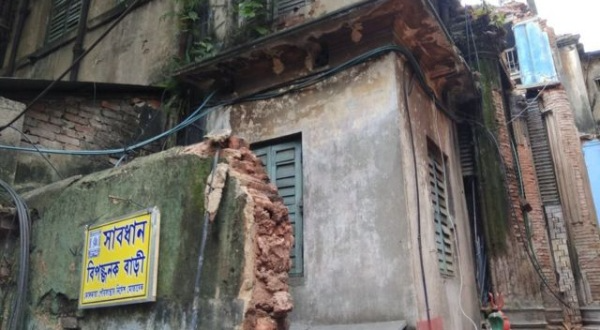Towering right next to the street stands a dilapidated building. The plaster has crumbled off the walls, exposing the bricks underneath. Tiny banyan and peepal saplings grow from cracks in the structure. A yellow sign hangs from the building, boldly warning in black letters: “CAUTION!” Such sights are all too common when walking through the lanes and bylanes of North Kolkata — countless ancient buildings in precarious condition. Yet, people continue to live in them, risking their lives. In some cases, even when the buildings are uninhabited, the owners keep them standing.
The Kolkata Municipal Corporation (KMC) had earlier identified more than 3,000 such structures across the city as “dangerous buildings.” According to KMC’s survey, these structures could collapse at any time during storms, rain, or cyclones, posing serious threats not just to residents but also to neighbors and passersby. Now, the KMC has started the process of demolishing 1,200 of these unsafe buildings, with plans to complete the work before the upcoming monsoon.
The list includes not just buildings in North Kolkata but also several old structures in Central Kolkata. KMC had issued multiple notices to property owners, urging them to repair these dangerous buildings. In some cases, courts had even ordered the evacuation of tenants. Yet, no action was taken. In fact, in many instances, KMC could not even trace the current owners.
During cyclones and monsoons in 2020–21, parts of such buildings collapsed, leading to the deaths of 20 residents. A similar incident occurred in 2021 when the roof of an old building in the Burrabazar area caved in, killing two people. To prevent such tragedies from recurring, a special amendment law was passed in the state assembly last year. Under this law, KMC was given full authority to demolish buildings marked as “extremely dangerous.” Now, ahead of this year’s monsoon, 1,200 buildings will be razed under that amendment.
However, doubts remain about how effectively this initiative will be carried out. So far, owners of around 100 buildings have received approval for new building plans. Agreements have been signed to ensure proper rehabilitation for tenants after the old structures are demolished and new ones built. But in most cases, tenants refuse to vacate. No matter how unsafe the shelter, people are reluctant to leave the only roof over their heads. Last year, KMC officials faced resistance and public outrage when trying to demolish such crumbling structures after the monsoon.
Will KMC be able to carry out this plan smoothly this year? Only time will tell.
Content and images sourced from Prohor

